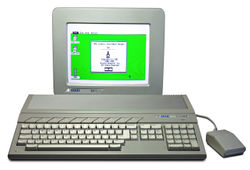Atari ST
| Atari ST | |
 |
|
| Released: | 1985-06-?? |
| Discontinued: | 1993-??-?? |
| Developer: | Atari |
| Type: | Hardware & Software |
The Atari ST is the successor to the popular Atari 8-bit line of home computers. The first model, the 520ST, was released in June 1985 and included the very first bitmap-based graphical user interface. Though it was able to obtain a respectable market share, it was displaced by IBM clones running the inferior DOS platform. Europeans still argue whether the Amiga or the Atari ST is the better machine.
Unlike other platforms of the day, the Atari ST did not come in different models for PAL and NTSC. Instead, software can switch from 60 to 50 Hz by themselves. European versions of TOS (the operating system) do just that. Connected to a monochrome monitor, the frequency is always 71 Hz and the screen resolution is doubled ("High"), which was useful for professional software, including audio. Games either adjust their graphics to the detected monochrome monitor, tell the gamer they need a color monitor, or ignorantly display a mess.
Contents
Games
Models
Atari produced several variations of the ST, and then went on to make additional base models including the STE, MEGA STE, TT030, and Falcon030.
Music and Sound
Each model of the Atari ST included an on-board YM2149, a 3-channel PSG. Upon keypress, TOS produces a short sound on the same PSG. Games turn either that sound or TOS altogether off.
It was also possible to connect external MIDI sound devices such as the Roland MT-32 for improved audio fidelity; while support for this feature was not especially widespread among games, a good few made use of it.
The upgraded model, the Atari STe added in two PCM audio channels, allowing the playback of samples; however, even fewer games made use of this feature than they did external MIDI audio, due to a general lack of titles which supported the STe's features.
Composition
Due to the built-in MIDI ports, much music for other platforms like the NES was made using Dr. T's KCS, Notator and Cubase.
Links
- en.wikipedia.org/wiki/Atari_ST - Wikipedia.